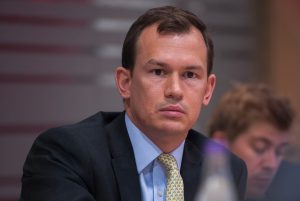As in banking, the trade credit insurance industry is seeing a flurry of new technology and platforms emerging to tackle old hurdles. But are they destined for greater success than previous attempts, or bound to face the same challenges? GTR and RKH gathered a group of industry leaders to discuss the new opportunities and concerns that technology brings to the table.
Roundtable participants
Damian Austin, European head of trade finance, Bank ABC
Andrew Barr, broker, credit and political risk, Texel Finance
Marilyn Blattner-Hoyle, head of supply chain and trade finance, AIG
Sam Evans, director, BPL Global
Neil Galletti, managing director, financial risks, RKH Specialty
Chris Hall, senior underwriter, global financial risks, Liberty Specialty Markets
Henry Mummé-Young, senior underwriter, specialty, The Channel Syndicate
Murray Ross, head of wholesale, political risk and credit, Chubb
Sanne Wass, senior reporter, GTR (chair)
GTR: Before we talk about all the new technology emerging, let’s chat about some of the platforms that have been around for a while – we have the likes of ITFex, LTPTrade, Tepfin, Mercury – and which have had various degrees of success. What was the original conceptual premise behind these? And what were the flaws in the thinking?
Austin: From a bank perspective, if I look at my business, and across trade finance and insurance, I think it’s fair to say that it is still an incredibly paper-intensive industry. For me, where I see fintech adding immediate value is in streamlining operational processes, harmonising documentation, creating e-contracts, and I don’t think any of the fintech platforms in the syndication space have nailed that part yet.
There have been a lot of platforms focusing on the front-end, especially in the interbank market, and frankly, if I speak to my fellow syndication professionals, it is not necessarily that part that the business is crying out to digitise. For me, custody, clearing and the back-end is the part where technology brings new investors to the table, and which brings insurance and the banking community together.
Hall: I saw an interesting stat that said that trade finance is an around US$9tn industry, and at any point in time there are about 4 billion sheets of paper circulating globally. That is just utterly inefficient. We have seen a number of banks try and bring out systems to make syndication neater, but they have never really caught on widely.
Blattner-Hoyle: Many technology platforms – and an example is the Aronova platform, which AIG and its clients are using, and which has been around for over 10 years – have been improved and widened over time with compelling attributes, but one of the issues is that they are often used for bespoke deals or specific situations. There are so many options and not enough widespread adoption across the trade world.
We have seen a lot of take-up in, for example, the diamond industry with certain banks, where there really was a need for something like Aronova to cover those risks. It gives great visibility and looks at policy conditions upfront to remove conditionality. But then, the banks don’t apply the tech to other assets where perhaps their risk doesn’t require it. And so you haven’t seen that wide-scale adoption.
We have just signed up to broker Willis’ Mercury system, and I see the same thing. Some things come through Mercury, some don’t. RKH has a platform where they try to put as much through as possible, but not everything, because it depends how the bank wants to send the data, if I understand correctly?
Galletti: Tepfin is RKH’s proprietary platform. The issue with Tepfin, which we created in 2004, is that it is owned by RKH. It is a credit insurance capacity distribution tool, accessible by anyone who wants to buy credit insurance capacity, but it is owned by RKH. Mercury is a Willis tool, and it is for Willis clients, but not everyone wants to be a Willis client, just like not everyone wants to be an RKH client.
ITFex and LTP were independently-owned and third-party platforms, but at the personal level, they were not actually third-party, they were created and used by industry individuals that were friends or friendly competitors. If you look at the creators of Google, Amazon or Facebook, no one actually knew who they were, and so there was an impartiality.
Ross: Just picking up on the word ‘flaws’ – when you look at Tepfin and Mercury, did they work? They did work. They did what they were designed to do: they were designed for the right kind of product, documentary instruments. But they did not take off in the way that people wanted them to.
I think there was a purely revenue-driven element to it. The challenge is, is there enough base income to drive the innovation in that space for that particular product? We sort of had a lull. Part of that was probably driven by the financial crisis, which meant that trade finance almost dried up overnight, so we went from Tepfin and Mercury – from my experience being pretty well utilised, generating a decent amount of income – to the taps being slightly turned off. Now, our market has expanded, and there are 60 people you have to compete with for business as an insurer, and there are more banks buying into it. That has almost injected a bit of energy back into this. So I don’t think anything is flawed; I think there is a new chance to get this going again.
Mummé-Young: We probably all agree what this sort of platform is for. It’s the greater efficiency, greater clarity of documentation, ease-of-use, but I don’t think everyone has worked out yet who they are for. If the broker comes up with it, it probably benefits the broker and the client. If an underwriter comes up with it, it’s probably for their benefit. For bank-to-bank platforms, banks have very similar documentary requirements to each other and the same fields that need to be entered. Whereas underwriters and banks have very different systems and requirements in terms of documentation. So, we are building platforms which are very efficient for one party, but does that mean they are efficient across the business? If we build something for driving down acquisition costs for underwriters, does that benefit brokers and clients? If it doesn’t, then it is never going to work.
GTR: We are now seeing a lot of new technology and platforms being developed. Are you seeing opportunities for that to better solve some of those problems? Or are there still issues that they are not addressing?
Hall: Toredo, which we recently launched, is a great way for us to help brokers, clients and indeed ourselves make insurance more efficient and easier to access and use. It is a slightly new principle, having been based on the Tepfin technology and then taken into a different legal construct. That, in theory, should remove some of the barriers to entry that we talked about earlier.
Notwithstanding that, there are a number of banks for whom the idea of having insurance online is definitely not their manner of doing business at the moment. But the technology angle, we think, is the only way forward. We all joke about how insurance can be old-fashioned, which just makes it very difficult to do business in what is effectively a volume game. You need to handle a serious number of transactions in this field to make it worthwhile. If we can’t do that efficiently, we are not going to be able to do business.
Blattner-Hoyle: That is exactly the problem, and the opportunity that we now have – which perhaps is different than 10 years ago – is that for the first time, we are actually seeing corporates say, ‘all of these platforms are very nice, but I don’t want a platform where my only insurer can be AIG and my only broker can be this or that person’. They now demand that they can have multiple banks, insurers and brokers on the same platform. I think that is why we are seeing a shift.
But really, the corporates have been going along, and supply chain finance is a perfect example of this. Corporates have just signed up to all of these different platforms as suppliers themselves, and others as buyers to cover as many suppliers as possible. Finally, which I think is a good thing, the corporates are saying no to endless different platforms that don’t connect. Because for them, too, profitability is key. They need to expand, but trade finance is not covering enough of their suppliers.
Should competitors be working through the same platforms? I think it’s not a choice anymore
Barr: Are you worried about concentration risk if everyone is using the same platform? There is so much at stake here, with regard to global trade.
Blattner-Hoyle: I don’t think everybody will use the same platform. What I believe we will see is that tools like APIs (application programming interfaces) will generate the potential to collaborate across systems, because banks aren’t going to change all their existing systems, and neither are insurers. We have done this with the platform we recently piloted with DHL. Through APIs, DHL could provide its data in a simple way, with its original systems. AIG, too, could use its own system, Aronova. APIs provided the information to TradeIX, which was then able to put it all onto blockchain so that it was available for everyone to see in an auditable way. None of us had to change our systems, which was the hurdle before. Now, people can talk to each other without the wholesale adoption of every single platform.
Austin: I think we are at a different stage now: corporate clients are now also demanding it. If you try and pitch for a large receivables or payables programme, if you have not got the technology, you are probably going to struggle to get through the door. More widely across trade finance, some of our corporate clients, for example across the Nordics, absolutely demand that you sign up to a system, or you don’t see a cent of business.
In addition, the financial services industry, and I include everyone in this room, not just banks, has finally woken up to the fact that if we don’t buy into digital, fintechs will have our breakfast, lunch and dinner. So, we are all to some extent playing catch-up. And in some regards, I think regulation has given us a little bit of breathing space there. There is now collaboration across fintech and the financial services sector, we have seen it is working, and there’s trust and integrity amongst the two coming together. For me, that is why we are at a different juncture now than we were even five years ago.
Evans: I agree that the tipping point is here in terms of this becoming the new norm. As you say, the clients demand it. Trade finance business is a volume game, and people are going to get left behind. So they need to embrace technology.
I think Toredo is the right way forward in lots of ways in this particular area of trade credit insurance, but my concern is that at the moment, having a broker-led platform, having a consortium of only three insurers, there is a danger that it will suck away the dynamism of the market. Going back to the point about the proprietary nature of the platforms, that has to be overcome, and that’s either on the broker side or the underwriting side.
GTR: Chris, are you planning to expand to let more underwriters onto Toredo?
Hall: Sam is spot on: to have a really efficient platform, you need more in the way of capacity, more people on it, and then that adds both practical capacity but also gravitas and market reach. I am sure that if we have this conversation in a number of years’ time, there would be considerably more parties on the system.
Mummé-Young: I think it is fair to say that Toredo is the thin end of the wedge at the moment. It just happens to be the first platform that is more for the trade finance bank-to-bank business. It is the start of it. Tepfin was probably ahead of its time. At the moment, it feels like fintech and insurtech is what everyone wants to talk about. Every 20-year-old with a laptop dreams of being a fintech billionaire. 14 years ago, when Tepfin started, that wasn’t really an option.
I think there are enough fintech solutions coming out now that it is worth the insurance market engaging. The clients need it, the banks need it, the insurers are driving efficiencies, and now is a good time to capitalise on the fact that people want to provide solutions.
GTR: Is the use of advanced technology in insurance a prerequisite for doing business going forward? And are you concerned that technology will eventually be the end of the syndications banker and insurance broker?
Evans: With the short-term trade finance business, the automation is great, but a lot of the transactions we do – emerging market risk, Africa-focused – if they were done with AI and fully automated, they just wouldn’t get placed. If you look at some of the African refineries, a large volume of that business – which I would argue is good business if you look at the default and recovery rate – wouldn’t happen. So there is always going to be a place for brokers. Even with the short-term trade finance business, there is always a move to a face-to-face meeting or a coffee.
In other classes of business that are not my speciality I think there is more a cause for concern, and some automation will creep in, but when you add value and the risks that you are placing are complex with hybrid structured transactions and more geopolitical uncertainty, for the foreseeable future, there is certainly a key role to be played.
Barr: This is particularly true considering the world moves very quickly. With current affairs and emerging markets, you can build platforms around green and red lights, but the world moves so quickly, politically and economically, that the platforms can’t always capture it.
Austin: We live in a world where underwriters, credit teams and bankers are looking at financials that are generally a year to 18 months out of date, and that will be part of their credit process. Nothing beats having seen the client last week or having been to the refinery. That will never change in my eyes. But technology on efficiencies is absolutely a prerequisite.
Mummé-Young: I agree with Sam, you need the brokers, the expert underwriters and the client meetings to place difficult deals. But there is a huge volume of transactions that we are not capturing which don’t require expert broking.
Blattner-Hoyle: There is always going to be the need, particularly in trade, for humans. It’s just, where do you need those humans? What do you need those humans to do? All of this doomsday stuff about computers taking over everything, I don’t buy it at all. I do think underwriting in terms of actually sitting at your desk and underwriting is going to change fundamentally. We are now looking at trying to use payment history and algorithms far more to be able to write limits. That hasn’t been easy to do in the past, because we couldn’t get the payment history that was current enough to make a good decision. Now, technology allows us to do that, and it opens up a huge, broad spectrum.
But I think we are all going to have jobs. The same with brokers. People say: ‘AIG did the blockchain pilot deal without a broker, is it the end of brokers?’ No, it isn’t. Brokers are key in our transactions.
Galletti: That was one of the main issues 10 years ago with trying to create trading platforms and build efficiencies. The first comment that we received from most of our friendly competitors was: ‘Are you mad?’ Their paranoia was around disintermediation. But if the brokers aren’t the innovators or don’t embrace the innovation, they will die one day.
Ross: It comes down to the expectation of what you want people to do. When I started out as a junior broker, my job was to stand in a queue for an awfully long time. My friends joked that I was a professional queuer. The role of the broker is going to change. The form the information takes is going to change.
GTR: Taking the example of Toredo, it is my impression that while it is currently for brokers only, at some point clients will be able to access it directly. So we might say now that it still needs the human touch, but won’t there be some business that brokers do today where they will lose out in the future?
Hall: You’re absolutely right, Toredo is broker access only at the moment, and clients will be able to access it directly later in 2018. But, that is not to the point of excluding brokers. We have three buzzwords: secure, transparent and efficient. The capacity is uploaded with pricing, making it transparent, but the real efficiency is the speed of turnaround, whether it is binding a transaction when you’re on the train, or giving a quote within a number of seconds. That has probably enhanced access by having a client putting a transaction in rather than sending it to their broker.
But, brokers need to be involved in a claim situation, and also in the client management side of things. And then similarly, there are going to be some clients who don’t want to access the system. They want their broker to perform the role they have always done, whether it’s vanilla or highly structured. So we can be flexible. It is just trying to make life easier for everyone: brokers, clients, and indeed ourselves.
Evans: The two markets, the banking and the insurance market, are still worlds apart, and you can’t expect banking clients or commodity traders to be experts in insurance. And with respect, the insurers are representing the needs of their capital providers, and as the broker, we are the agent of the insured, so there is a professional expertise that is added there. Whilst all of these glossy platforms can make it seem quite seamless, it is only when the chips are down that you question, oh, what was this wording point? There is not a generic form for the bespoke wordings that are currently used.
GTR: We have talked about Toredo on the trade credit side. Meanwhile, on the banking side, we have seen a lot of platforms emerging as well, including many blockchain initiatives. Should banks and insurers work together on these platforms? Should they merge?
Blattner-Hoyle: The AIG strategy within the trade finance area is that they should merge, to drive adoption, efficiency and profitability. It doesn’t make sense if we are making a platform that doesn’t work with the bank platforms, because we have then created yet another hurdle between ourselves and our client.
Our work with TradeIX is a perfect example, where we merged what the bank needed and what the insurer needed. We are trying to create a wider app that could be available to all of our insurance competitors and the brokers, and which would allow all the banks in, say, Marco Polo to access the same portal. We see that as a huge benefit, and not as something where we can block out other insurers or brokers.
Tradeteq is another example – they are focused on the non-bank investor side, which AIG is also working on. So we are trying to figure out how we can invest in an asset class that we traditionally haven’t invested in. LiquidX is another. All of these are pulling together insurance and banks. There will be winners and losers, but ecosystem connectivity and ease of use must pull everything together.
Austin: If we are looking at the platforms in the distribution space, and there are quite a few at the moment, there will be winners and losers. I don’t think there is enough space for three or four platforms for the interbank market. There will be some consolidation.
I think banks will embrace the platforms, which will bring a whole new investor base to the asset class. But we as bankers need to provide a lot of education to non-bank investors, such as pension funds and institutional investors, who have got billions of capital to deploy and like the idea of low-risk, self-liquidating transactions, but don’t really understand the complexity.
Mummé-Young: Where the value could be added is on structured data capture, so that we are all using the same information, but we can use separate platforms that can talk to each other without merging them. That is probably where we are going to be successful.
Austin: I agree. We saw a fintech solution yesterday, which would enable a credit insurer to look at the same set of data across a portfolio of debtors that the bank is looking at. The client and/or bank can decide whether it wants to wrap the portfolio with insurance; the bank can decide whether it wants to fund the whole portfolio or certain receivables within it; and the insurer can ascertain whether this is a portfolio they can insure. If you get that together, the ultimate winner is the client on speed of execution and potentially cost, but also the bank and the underwriter. That is a big step forward for banking and insurance working together.
GTR: How are you seeing other lines of business in banking and insurance innovating? Is trade finance and credit insurance lagging behind? Could you learn anything from other sides of the business?
Mummé-Young: At the moment Lloyd’s of London is putting a lot of time and effort into its Lloyd’s lab, where it is trying to actively engage with tech startups to see if there are any universal insurance problems which can be solved. Apparently, there are some very impressive people coming through, with some very good ideas. Now, not all of them are going to work, because they are not always targeted at the right people, but there is a lot of time and effort from Lloyd’s to help solve insurance-wide issues.
To answer your question, we are a long way behind other insurance products. You can buy house insurance on your phone. I was in the airport, and I forgot to buy travel insurance, so I bought it while queueing for a coffee. You just can’t do that with what we do, because it is specialist insurance. So I think we are a long way behind, but because of the complexity of what we do, this isn’t a one-size-fits-all kind of thing. I’m sure trade finance could get better at the banks, but it will not be the same as accessing your account online with two clicks.
Another point is that we are growing, and we are getting more sophisticated, but we are still a very small part of the general insurance market. Compared to others, if you look at the property market for example, we are tiny. So where is the money from Marsh, Willis, AIG, Chubb going to go? It is not going to go into short-term trade finance solutions, because that is not where income is generated.
Hall: As someone who has recently moved from banking to insurance, there is a little bit of a difference in my mind in that many of the banks have huge digital divisions and they are spending large amounts of money. That said, in the trade finance world, I am not aware of any of the banks which are really investing a huge amount to do anything new from a digital perspective. Trade finance is hugely important globally, but there is still not a huge amount of money being spent on innovation. So in that respect, I don’t think we are behind in insurance versus banking. We are all trying to drive in the same direction, but we haven’t got there yet.
Galletti: I think we’re possibly a bit behind in the investment. I hear eye-watering numbers that some banks are putting aside for technology. I heard of a bank that has just signed off on £2bn as a five-year investment in technology.
Austin: Compared to other forms of banking, trade is many years behind and trying to catch up. As a retail client in the UK, I can go on my phone and get an unsecured loan in two clicks and the money can be in my account within 20 minutes if I am within pre-approved limits. A corporate borrower can’t do that. If you look at the payments space, banks have spent huge amounts on systems and digital automation to the point where new entrants have got to spend an awful lot of money just to keep up.
But in trade, it is still a fairly open game for most banks. The feeling I am getting is that banks that invested early, their technology now needs to be reinvested in, and a lot are now realising that, actually, working with a fintech company may be a cheaper and longer-term viable solution than trying to build it yourself.
Barr: I think it is very easy to invest poorly in fintech, because there is so much out there and so many different ideas going in multiple directions. Even if a bank is spending X amount of money, these banks are set up as very siloed institutions with regards to different lending lines. Having the investments filter down to something which would directly affect the lending lines – which would then feed into credit insurance – can take an awfully long time.


















